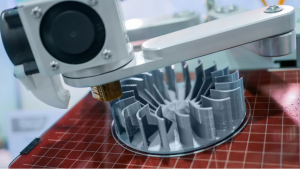Success Story: Translating Content for 3D Printing and Additive Manufacturing

Picture by Marina_Skoropadskaya (Getty Images) via Canva
Translating Content for 3D Printing and the Importance of Specialist Translators
3D printing might seem new, but mention of this technology was first made in 1981 when the Japanese inventor Dr Hideo Kodama filed a patent for a “rapid prototyping device”. Even though he wasn’t granted the patent, Kodama is considered to be the person who first invented this technology.
Since then, it has evolved and improved. Now, increasingly, the technology has greater areas of application and is transforming the world of manufacturing. In the book, ‘Additive Manufacturing: A Tool for Industrial Revolution 4.0,’ the authors S. Anand Kumar and R.V.S Prasad explain that “because of continuous demand for more complexity in design and efficient use of materials, three-dimensional (3D) printing, commonly known as additive manufacturing (AM), has expanded exponentially in terms of application as well as development.”
The term additive manufacturing is also used for 3D printing. Both terms refer to the same process. These terms describe the process used to create objects by building up layer upon layer of material through using CAD (Computer Assisted Design) files.
In recent years, there has been a transformation in 3D technology, and there are now many companies that manufacture 3D printers worldwide. There are also companies that research and manufacture filaments and other associated materials, and companies that develop software for 3D design.
CHALLENGE:
Like any area of expertise, additive manufacturing or 3D printing has its own terminology and associated style. It’s crucial to know how to talk about it for industry-related communications.
Finding specialist translators in this area for 15 language combinations was challenging. It’s a new world constantly evolving, and the translators and editors are learning as they go.
Because this is such a new area, we found that terminology existed for a particular market with more than one translation. We also found concepts that had never before been translated, for which no standard translation is used. What’s more, industry-specialist articles contain a range of inconsistencies and different ways of saying the same thing.

Picture by Zyabich (Getty Images) via Canva
SOLUTION:
To start work, we created teams of two specialist translators for each language combination while conducting a range of quality assurance tests. This enabled us to have a team for each language combination that we have trained throughout the process, while on the job.
We also work with specific glossaries for individual customers, as well as with style guides for each language. We’ve refined the glossaries over time with the help of our customers (3D printer manufacturers) and we’ve evolved and learned together with our translators and editors.
We also work with computer assisted translation programs that enable us to create translation memories for individual customers. These memories are refined on the basis of the final documents delivered to customers to ensure high levels of accuracy and quality control.
Currently, the teams we created, together with the project managers, are in charge of translating and revising technical documentation (user manuals), marketing content (our customers’ success stories, communications and banners), SEO content to improve search engine visibility and the printers’ user interface texts. Everything needs to be coordinated properly and all content needs to use the same terminology and style.
LocalizationLab was established to assist some of the most renowned 3D printer manufacturers to translate their training and user interface material. We started our company in this vein, to translate the user interface of 2D and 3D printers into more than 15 languages.
Since then, we’ve specialised in translating and editing content related to 3D printing and additive manufacturing, both technical documentation (user manuals, software strings) and marketing and software material, in more than 15 languages. We’ve evolved alongside our customers in the additive manufacturing and 3D printing industry.
If you’re a manufacturer of 3D printers or additive manufacturing, or a software developer, and you need help to reach customers in other countries, please drop us a line at info@localizationlab.com. We’d be delighted to help connect you to your customers worldwide.
